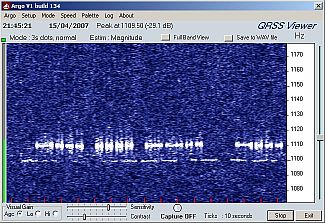What have I been hearing?
The first impression I had of the band was that signals were strong despite the low 100mW erp. Quite a few of the stations are copyable at up to s9. My noise level also seems to be relatively low and normally causes no problems - I was particularly concerned that this might not be so as a few years ago I had terrible noise on 136kHz from a neighbour's TV, and I am right in the middle of a suburban estate where a high noise level seems inevitable these days.
To give you an idea of what the band sounds like I have made a few recordings of stations I have received as follows:
G3DXZ Retford 15 July 2007
G3KEV Scarborough 4 June 2007
G3OLB Sheldon, Devon 4 August 2007
G3UNT Maidstone 2 June 2007
G3VTT nr. Rochester 5 June 2007
G3XAQ Canterbury 5 June 2007
G3XIZ Biggleswade 4 June 2007
G3YXM Birmingham 29 June 2007
G4GDR Swindon 16 June 2007
GM4SLV Shetland Is 30 September 2007
GW3UEP 25th July 2007
GW4HXO Haverford West 16 June 2007
M0BMU Hatfield 29 June 2007
As I hear new stations I will endeavour to record these as well and upload them to the same place. If your signal is among the recordings I would welcome comments (email address on my home page).

I mentioned earlier that some of the operators use QRSS, or slow CW. This is a technique where the morse characters are sent very slowly and at the receiving end copied via a computer sound card. It allows very weak signals to be copied below the noise level where they would not be audible by ear. 3 second dots are commonly used on 500kHz, dots as long as 60 seconds have been used in transatlantic tests on 136kHz, so a QSO takes many hours! Argo, a program developed by Alberto, I2PHD, is a popular software for decoding QRSS, find it on his weaksignals website.
I have never been that much of an enthusiast for QRSS, but have had a short listen on the mode using Argo. This screenshot is of SM6BHZ, the stronger upper trace, signing BHZ and DI2AG, on 505.1kHz. In the evenings SM6BHZ peaks 589 so QRSS is hardly necessary - he runs around 10W erp, much higher than other stations, and it clearly makes a difference. I have also heard DI2AG by ear, but he is much weaker.
Stations worked at G3YMC on 500kHz
Callsign Name QTH Locator
G3AQC Laurie Chichester
G3KZU Mike Oxford
G3OLB Tom Honiton, Devon
G3UNT Brian Maidstone
G3VTT Colin Rochester JO01GK
G3WCB Dave Iver, Bucks IO91RM
G3XAQ Alan nr. Canterbury
G3XIZ Chris Biggleswade
G3XVL Chris Ipswich JO02NB
G4GDR Adrian Highworth, Wilts
M0BMU Jim Hatfield
December 2007 - I am currently taking a break from 500kHz so that I can use the vertical on 160m during the winter season. I hope to be back in the spring.
500kHz Websites
There are relatively few websites specifically for 500kHz, but the following is a selection of associated LF and MF sites.
G3YXM - very active on 136kHz in the early
days. Extensive site with lots of links and now with a small section on 500kHz.
G3NYK - Alan is a propagation
expert on 136kHz and he has an extensive site with links. Also a 500kHz erp
spreadsheet.
M0BMU's FET PA
Transmitter producing around 11W on 500kHz.
PA0SE's Field Strength meter -
several ops have modified this for 500kHz and have been taking measurements with
interesting results.
Roger G3XBM - a fellow QRP enthusiast who now has
some 500kHz pages on his website.
G0MRF 500kHz low pass filter -
as used in the G3YMC transmitter.
John GM4SLV - in the Shetland Islands, currently
the most northerly operator on the band. You will find a recording of G3YMC there!
USA 500kHz group website - what goes on across the
pond.
G4WGT's pages - Gary has
some pages on short vertical antennas not dissimilar from mine.
Sites will be added as they become available.